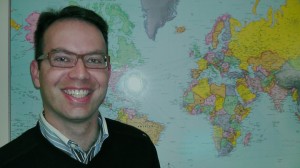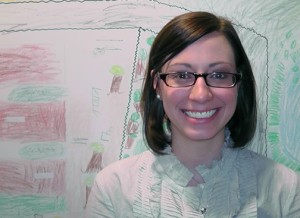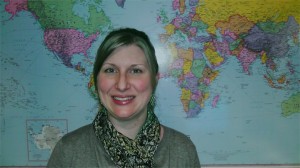The GLOBE Program is excited to announce the relaunch of the GLOBE Scientists’ Blog! This blog will be a place where GLOBE Scientists can share their thoughts about a variety of scientific topics. In January 2011, three new scientists from the National Center for Atmospheric Research (NCAR) in Boulder, CO joined the GLOBE Program Office as support to the Science and Education team. These three scientists are Duncan Axisa, Jessica Mackaro, and Sarah Tessendorf.
 Duncan Axisa is an Associate Scientist at NCAR’s Research Applications Laboratory. Duncan is responsible for a set of instruments that are operated on research aircraft during field experiments. His interests lie primarily in aerosol and cloud studies using airborne platforms. Duncan has special expertise in instrumentation that measure atmospheric properties and collect data on the physics of tiny particulates that are suspended in the atmosphere. These data are extremely important for understanding cloud and precipitation formation as well as the atmospheric environment in which they occur. Duncan has worked on several intensive field campaigns including measurement flights in the California Sierra Nevada, the U.S. Southwest and Southern Plains, the Texas Gulf Coast, the Istanbul metropolitan area, the Saudi Arabian desert and the Indian monsoon region.
Duncan Axisa is an Associate Scientist at NCAR’s Research Applications Laboratory. Duncan is responsible for a set of instruments that are operated on research aircraft during field experiments. His interests lie primarily in aerosol and cloud studies using airborne platforms. Duncan has special expertise in instrumentation that measure atmospheric properties and collect data on the physics of tiny particulates that are suspended in the atmosphere. These data are extremely important for understanding cloud and precipitation formation as well as the atmospheric environment in which they occur. Duncan has worked on several intensive field campaigns including measurement flights in the California Sierra Nevada, the U.S. Southwest and Southern Plains, the Texas Gulf Coast, the Istanbul metropolitan area, the Saudi Arabian desert and the Indian monsoon region.
Duncan earned a master’s degree from Texas A&M University in Atmospheric Science after coming to the United States from the Mediterranean island nation of Malta, where he worked as a meteorologist and tought math and physics. He received his bachelor’s degree in education there, too, where he focused his dissertation on curriculum development in aviation meteorology at the University of Malta. Due to his specialized knowledge, Duncan assists The GLOBE Program with instrumentation-related tasks and provides specific scientific support to the Science and Education Team.
 Jessica Mackaro is an Associate Scientist at NCAR’s Earth System Laboratory. Jessica’s general area of research is climate variability and climate change research, primarily in relation to the global energy and water cycles. She has studied various reanalysis datasets and their ability to simulate the changing energy and water cycles. Due to her specialized training in climate, Jessica assists the GLOBE program with the new Student Climate Research Campaign (SCRC) as well as provides scientific support to other projects. Jessica is excited to be working with the GLOBE program, as it gives her the opportunity to relate her research interests the engagement and education of teachers and students.
Jessica Mackaro is an Associate Scientist at NCAR’s Earth System Laboratory. Jessica’s general area of research is climate variability and climate change research, primarily in relation to the global energy and water cycles. She has studied various reanalysis datasets and their ability to simulate the changing energy and water cycles. Due to her specialized training in climate, Jessica assists the GLOBE program with the new Student Climate Research Campaign (SCRC) as well as provides scientific support to other projects. Jessica is excited to be working with the GLOBE program, as it gives her the opportunity to relate her research interests the engagement and education of teachers and students.
Jessica’s interest in atmospheric science began as a child, specifically with regards to tropical cyclones. She attended Millersville University in Millersville, PA where she obtained a bachelor’s degree in Meteorology and a bachelor’s degree in Mathematics. From there she moved to Huntsville, AL, where she obtained her master’s degree in Atmospheric Science, working with a group of NASA Scientists to examine tropical cyclone development in NASA’s earth system model.
 Sarah Tessendorf is a Project Scientist at NCAR’s Research Applications Laboratory. Sarah’s general area of research is cloud physics, focusing on aerosol impacts on clouds and precipitation. She also works with computer modelers to improve and validate cloud microphysics model parameterizations using observations from radars, raindrop disdrometers, and other surface measurements. She has studied hail formation in severe storms, lightning, and cloud seeding effects on rain formation. She considers herself primarily to be an “observationalist”; working mostly with radar and in situ cloud and aerosol measurements, but she also has experience using cloud models for microphysical studies.
Sarah Tessendorf is a Project Scientist at NCAR’s Research Applications Laboratory. Sarah’s general area of research is cloud physics, focusing on aerosol impacts on clouds and precipitation. She also works with computer modelers to improve and validate cloud microphysics model parameterizations using observations from radars, raindrop disdrometers, and other surface measurements. She has studied hail formation in severe storms, lightning, and cloud seeding effects on rain formation. She considers herself primarily to be an “observationalist”; working mostly with radar and in situ cloud and aerosol measurements, but she also has experience using cloud models for microphysical studies.
Sarah became fascinated by weather, especially severe storms and tornadoes, as a young child growing up in Kansas and Nebraska. She went on to earn her bachelor’s degree in Meteorology/Climatology at the University of Nebraska-Lincoln and then she moved to Colorado, where she received her master’s and doctorate degrees from Colorado State University in Atmospheric Science.
Some of Sarah’s unique experiences include her involvement with a UCAR student program called SOARS (Significant Opportunities in Atmospheric Research and Science), initially as a student (referred to as a protégé in the program), then as a Steering Committee member, and currently as a mentor. Through her involvement with the SOARS program, Sarah became interested in working with students and education and outreach. She has completed formal education in multicultural curriculum development, as well as has a variety of experiences leading workshops for students and science teachers. She is also an instructor at the University of Colorado-Boulder, where she has taught the introductory course on weather and the atmosphere.
Sarah’s mission when it comes to working in education and outreach is to help create a more scientifically literate population, which is what she hopes to work on as part of GLOBE. She is very much interested in how to effectively teach and engage students in science, especially those with a variety of different learning styles who may not always excel in science if taught with traditional methods. She would also like to help GLOBE expand to more schools and to work with more scientists, thus helping to bridge the gap between science and the classroom.
Each scientist is helping to prepare for the SCRC, coming in September. From the SCRC website: “The SCRC aims to engage students in measuring, investigating, and understanding the climate system in their local communities and around the world. Drawing on GLOBE protocols and data, as well as other datasets, students take climate-related measurements and investigate research questions about climate.”
Participation in this campaign will allow students to contribute to climate science studies, connect with other schools and classrooms across the globe, and be inspired to explore and conduct research experiments of their own, all with the goal of increasing awareness of climate-related environmental issues and Earth as a system.
This campaign is designed around three distinct components, and can be used individually or in conjunction with each other. These components are intensive observing periods (IOPs), research investigations, and climate foundations. Each component can be found on the SCRC website in greater detail.
All GLOBE schools are encouraged to join in the SCRC and can join by clicking on the link on the SCRC homepage. We, the scientists of The GLOBE Program Office, look forward to working with our student scientists throughout the world throughout the course of the SCRC. We also look forward to engaging in conversation with you here on this blog!





